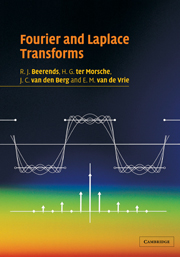Book contents
- Frontmatter
- Contents
- Preface
- Introduction
- Part 1 Applications and foundations
- Part 2 Fourier series
- Part 3 Fourier integrals and distributions
- Part 4 Laplace transforms
- Part 5 Discrete transforms
- 15 Sampling of continuous-time signals
- 16 The discrete Fourier transform
- 17 The Fast Fourier Transform
- 18 The z-transform
- 19 Applications of discrete transforms
- Literature
- Tables of transforms and properties
- Index
16 - The discrete Fourier transform
Published online by Cambridge University Press: 05 June 2012
- Frontmatter
- Contents
- Preface
- Introduction
- Part 1 Applications and foundations
- Part 2 Fourier series
- Part 3 Fourier integrals and distributions
- Part 4 Laplace transforms
- Part 5 Discrete transforms
- 15 Sampling of continuous-time signals
- 16 The discrete Fourier transform
- 17 The Fast Fourier Transform
- 18 The z-transform
- 19 Applications of discrete transforms
- Literature
- Tables of transforms and properties
- Index
Summary
INTRODUCTION
From parts 2 and 3 it is obvious that Fourier series and Fourier integrals play an important role in the analysis of continuous-time signals. In many cases we are forced to calculate the Fourier coefficients or the Fourier integral on the basis of a given sampling of the signal. We are therefore interested in a transformation that will transform a discrete-time signal, in this case a sampling, directly into the frequency domain. In general, such transformations are called discrete transforms. A particularly important discrete transform is the so-called discrete Fourier transform, abbreviated as DFT, and it will be the central theme of the present chapter. It arises naturally if one approximates the Fourier coefficients of a periodic continuous-time signal numerically using the trapezoidal rule. This is the subject of the first section of this chapter, which also introduces the DFT as a transform defined for periodic discrete-time signals. In the next section we introduce the inverse DFT in the so-called fundamental theorem of the discrete Fourier transform, which very much resembles the fundamental theorem of Fourier series. In the remaining sections, all kinds of properties of the DFT are treated, and again we will encounter many similarities with Fourier series and Fourier integrals. For example, one can formulate a Parseval theorem for periodic discrete-time signals. Following the introduction of the so-called cyclical convolution we can derive convolution theorems, which look very similar to the ones derived for continuous-time signals.
- Type
- Chapter
- Information
- Fourier and Laplace Transforms , pp. 356 - 374Publisher: Cambridge University PressPrint publication year: 2003



